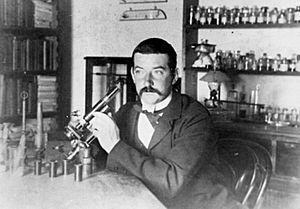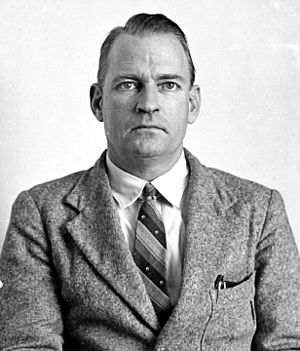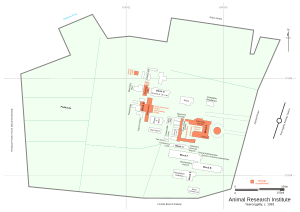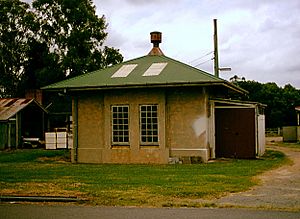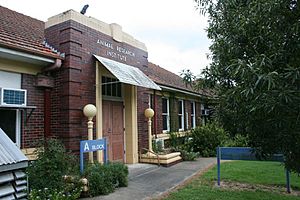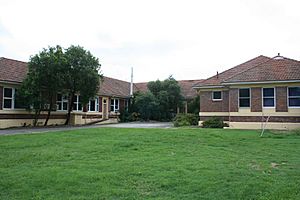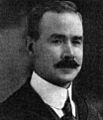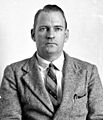Animal Research Institute Buildings facts for kids
Quick facts for kids Animal Research Institute Buildings |
|
|---|---|
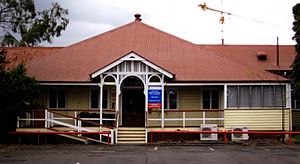
Stock Experiment Station main building, 2008
|
|
| Location | 681 Fairfield Road, Yeerongpilly, City of Brisbane, Queensland, Australia |
| Official name: Animal Research Institute (former), Stock Experiment Station (1909-1932), Animal Research Station (1932-1953) | |
| Type | state heritage (built) |
| Designated | 13 June 2008 |
| Reference no. | 602598 |
| Significant period | 1909 - 2010 |
| Lua error in Module:Location_map at line 420: attempt to index field 'wikibase' (a nil value). | |
The Animal Research Institute Buildings are a group of historic buildings in Yeerongpilly, Australia. They were once home to a special research station. This station was set up to study and control diseases in farm animals. It also helped develop important vaccines. Over the years, the buildings were expanded and used by different groups. This included the University of Queensland for vet training and the Commonwealth Scientific and Industrial Research Organisation (CSIRO). The site was added to the Queensland Heritage Register in 2008 because of its important history.
Contents
History of Animal Research
The Animal Research Institute started in 1909. It was first called the Stock Experiment Station. This was Australia's first farm-based facility built just for animal research. Its main goal was to fight diseases in animals like cattle. They also worked on making animals healthier and more productive.
In 1893, the Queensland Stock Institute was created. It was the first of its kind in Australia. It started in rented rooms in Turbot Street, Brisbane. A scientist named Charles Joseph Pound led the work.
Pound was a very skilled microscopist. He trained in London and Paris. He learned how to develop vaccines, which was a new technology then.
In 1894, Pound made a huge discovery. He proved that cattle ticks spread a deadly illness called Redwater Disease. This disease was killing many cattle in Queensland. Pound then created the first inoculation (a type of vaccine) for this disease in Australia. He even invented a special syringe to help farmers give the vaccine. His work greatly helped Queensland's cattle industry.
In 1897, the Institute became part of the Queensland Department of Agriculture. New buildings were built for it in Normanby (now Spring Hill) in 1899. These buildings had laboratories, a museum, and rooms for experiments.
Later, Charles Pound was moved to a different department. He was the only scientist in Australia making tuberculin. This was used to diagnose tuberculosis in humans and cattle.
In 1907, the Institute returned to the Department of Agriculture. Dr. Sydney Dodd was put in charge. He continued research on cattle ticks. He suggested buying land at Yeerongpilly for a new experimental station. This site was good because it was surrounded by a river and railway lines. This helped stop diseases from spreading.
The Yeerongpilly area had been used for farming since the 1850s. Crops like arrowroot, cotton, and sugar cane were grown there. The railway came in the 1880s, bringing more homes. But floods in 1893 slowed development.
The Yeerongpilly Station Opens
The Stock Experiment Station at Yeerongpilly opened in 1909. Queensland was the first state to have such a facility. The main building was made of timber. It had offices and laboratories. There was also a stable, animal yards, and a post-mortem room.
The stable built in 1909 had four stalls for animals. It also had a room for tools and a special room for small animals. A tramway inside helped move dead animals.
In 1910, Dr. Dodd left. Charles Pound returned and led the station until 1932. The facility was then renamed the Animal Health Station. A new wing was added to the main building for more laboratories.
In the 1920s, a separate building for post-mortems was built. A new one, the Animal Morgue, was built in 1934. It was made mostly of concrete for easy cleaning. It had a special table for examining animals.
Veterinary School and WWII
In the 1930s, the station started research on pig and poultry nutrition. In 1939, the Animal Health Station became a veterinary school for the University of Queensland. This was important for Queensland's farming industry. The state needed its own vets.
The first part of the Veterinary School was finished in 1938. The old stable was changed to be used for anatomy lessons. By 1940, the school was fully built. It had laboratories, offices, lecture rooms, and operating theatres for animals. It also had a hospital block with stalls for cattle, horses, and smaller animals.
During World War II, the Veterinary School closed temporarily. The U.S. Army's 3rd Medical Laboratory used the buildings from 1942. They checked water and food. They also investigated outbreaks of diseases. This helped keep US troops healthy in the tropical environment. The 3rd Medical Laboratory also served as a Malaria School.
The circular garden and flagpole in front of the Veterinary School are from this time. They are typical of US Army designs. The Veterinary School was given back to the government in 1944.
CSIRO and Later Years
From the 1930s, the Council of Scientific and Industrial Research (CSIR), later CSIRO, also worked at Yeerongpilly. They collaborated with the Department of Agriculture. Dr. Frederick Hugh Sherston Roberts was a key scientist there. He specialized in animal parasites.
After World War II, CSIRO used the main building. In 1947, Dr. Roberts became head of CSIRO's Veterinary Parasitology Laboratory at Yeerongpilly. This lab became famous worldwide for its work on cattle diseases. More buildings were added for CSIRO's work.
In 1954, the Animal Health Station was renamed the Animal Research Institute. CSIRO moved to new labs in 1967. Queensland Government staff then used the main building again.
In 1952, part of the site was used for the Tennyson Power Station. This power station has since been taken down.
The Institute did important work over the years. They tested for diseases in many animals. They are famous for their research on cattle tick fever. They also developed vaccines for many animal illnesses. This research greatly helped Queensland's farming industries.
In 1999, a new lab was opened in Wacol. It was named the CJ Pound Laboratory, honoring Charles Pound. He was called the "boffin" who "saved the cattle industry."
The Animal Research Institute left the Yeerongpilly site in 2011. The area is now being redeveloped.
What the Buildings Look Like
The former Animal Research Institute is a group of buildings and animal pens. It sits on a 12-hectare site in Yeerongpilly. The most important buildings are:
- The Stock Experiment Station Main Building (from 1909)
- A Stable (from 1909)
- The Animal Morgue (from 1934)
- The Veterinary School Main Building and Hospital Block (from 1938-1940)
These buildings are on higher ground on the eastern side of the site. The rest of the area has large, fenced grass yards.
Stock Experiment Station Main Building
This is a large timber building. It has a central part from 1909. Wings were added to the north in 1932 and to the south in 1950. It has verandahs, some of which are now enclosed. The building has a hipped roof.
The different parts of the building look a bit different. The 1909 part has a Federation style. The northern wing (1932) looks more classical. The southern wing (1950) has a more modern, functional style. The outside is covered with timber boards.
Inside, the 1909 part has six rooms and a central hall. The main laboratory still has some original shelves and workbenches. Many rooms have decorative pressed metal ceilings.
Stable
The Stable (1909) is near the Stock Experiment Station Main Building. It is a long timber building with a hipped roof. The floor is concrete, but some early brick flooring can still be seen. It has been divided into several rooms.
Animal Morgue
The Animal Morgue (1934) is north of the Stable. It is a concrete building with a pyramid roof. A large metal vent is on top. Inside, the walls are smooth concrete. The floor is also concrete. There is a special concrete table for examining animals. Foot-operated taps are still there.
Veterinary School Main Building
This building is south-east of the Stock Experiment Station Main Building. It faces east. It is a large, U-shaped brick building with a tiled roof. It has a classical design. The outside is made of glazed brick.
The entrance has a special design with brick planters. Inside, the main entrance has a terrazzo floor. The building has a central hallway that leads to many rooms. These rooms include laboratories, offices, and lecture rooms. There is also an animal operating theatre and a post-mortem room.
Many original items are still inside. These include concrete workbenches, timber cabinets, and display cases. The toilets also have original fixtures.
In front of the building is a large, circular garden bed. A steel flagpole from World War II is in its center.
Veterinary School Hospital Block
This building is west of the Veterinary School Main Building. It is L-shaped and forms a large courtyard. It has small stalls for animals. There is also a two-level fodder store for animal feed. A blacksmith's room with a forge is also part of the block.
The hospital block uses both brick and timber. It has skillion roofs (sloping roofs). The animal stalls have painted brick walls and concrete floors. There are also workrooms with timber windows.
Why These Buildings Are Important
The Animal Research Institute Buildings are important for several reasons:
- Showing Queensland's History: This place was the oldest animal research facility in Queensland. It shows how important farming and livestock have been to Queensland's economy. It also shows how the government supported this industry through science.
- Showing What These Places Are Like: The buildings show what an animal research facility needs. This includes labs, offices, animal housing, and places for post-mortems. The Veterinary School buildings also show what Queensland's first vet school looked like. They still have many original features and equipment.
- Special People and Groups: The buildings are linked to important people. Charles Joseph Pound worked here. He developed the vaccine that saved Queensland's cattle from Redwater Disease. Dr. Frederick Hugh Sherston Roberts also worked here. Under his leadership, the institute became famous worldwide for its research on cattle diseases.
See Also
- Animal Research Institute, Yeerongpilly
Images for kids


